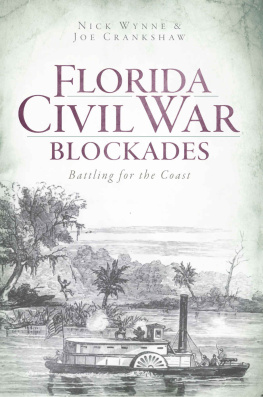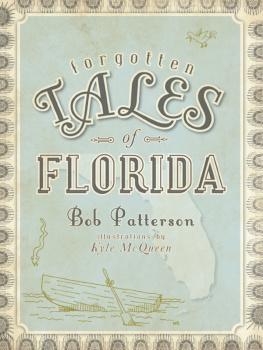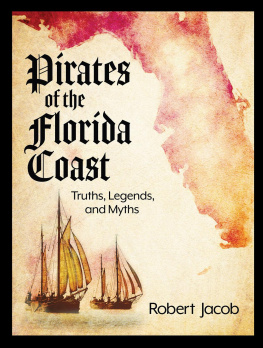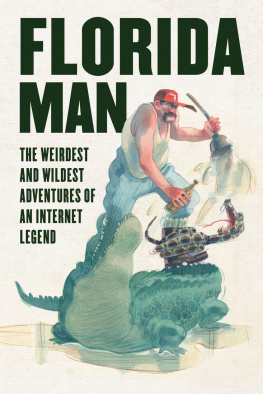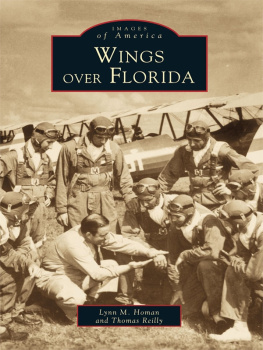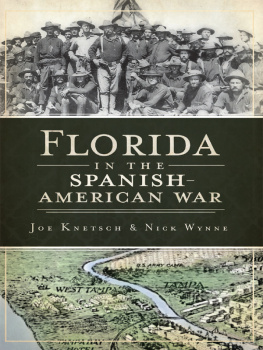Chapter 1
CLOUDY SKIES IN THE SUNSHINE STATE
Prewar Florida
This great Nation will endure as it has endured, will revive and will prosper. So, first of all, let me assert my firm belief that the only thing we have to fear is fear itselfnameless, unreasoning, unjustified terror which paralyzes needed efforts to convert retreat into advance.
Franklin Delano Roosevelt, 1933
God must love the common man, Abraham Lincoln once said. He made so many of them. Florida in the 1930s was very much the land of the common man and bore little resemblance to the Sunshine State of the 1920s, when everybody of any importance came to see and be seen. The land boom, which had fueled the economy for more than half a decade, was moribund by 1927, and the collapse of the states banking system, which had provided easy credit, was the coup de grce to its foundering economy. Raw land, once a commodity worth untold millions, lay fallow, occasionally pockmarked by empty subdivisions awaiting optimistic builders to construct new homes for phantom buyers who never came. The annual migration of tourists, long considered as predictable as the yearly flights of wild birds, slowed to a standstill, while the millions of dollars they brought with them diminished to a mere trickle. Although Miami and Palm Beach still maintained a faade of the hurly-burly of the previous decade, hoteliers found it necessary to offer deeply discounted rates to attract paying customers. The advertising mills still turned out brochures that featured the high jinks of the wealthy cavorting on beaches or partying in casinos and nightclubs, but the volume of such advertisementsonce a raging torrent of paper and picturesslowed and gradually dried up as profit margins decreased. Even in these once fabled playgrounds, changes were in the air.
In Carl Fishers Miami Beach and Glenn Curtisss Hialeah, the nations criminal element, led by the notorious Alphonse Scarface Al Capone, now ruled. Movie stars and sports figures, among South Floridas major attractions, still came to Miami, but not in the numbers they once did. In Palm Beach, scions of established fortunes and their families withdrew to their mansions in compounds hidden behind walls of sea grapes and coquina, safe from the envious eyes of the common man, whom many feared might just embrace a revolutionary approach to resolving the disparity between Americas rich and poor.
Across the peninsula, Floridians hunkered down, trying to salvage what they could from the halcyon days of the Florida boom. While the state might have returned to the control of the common people, the reality was that significant changes had taken place during the previous decade. Although there were vast areas of rural landscape, Florida had morphed from a predominantly agricultural state into an urban one. In 1920, 63.5 percent of the population lived on farms or in small towns of fewer than 2,500 persons. By 1930, 51.7 percent of Floridians lived in towns of 2,500 persons or more. Jacksonville, with its 173,000 residents, was the states largest city, but Miami (172,000) followed closely behind. Tampa, with its population of 108,000, ran a distant third. The other metropolitan areas of the stateOrlando, Tallahassee, Pensacola, St. Petersburgmeasured their populations in the lesser thousands. Regardless of locale, the Sunshine States 1.9 million residents faced a bleak future.
Unemployment, which hit a nationwide high of 25.0 percent in 1932 and averaged 17.3 percent for the remainder of the decade, was even higher in the Sunshine State. With no major industries producing essential goods, Floridas service industries found it difficult to absorb the growing urban population. Some, like Tampas cigar industry, continued to operate, but even that mainstay of the citys economy experienced layoffs and reduced production. In Ybor City, the Latin community of Tampa, workers radical support for socialism and the Spanish Republic gave civic leaders concerns about what the future held in such unstable economic times. More conservative community leaders lent their support to an incipient fascist movement, drawing their ideological models from the orderly and apparently prosperous regimes of Benito Mussolini and, later, Adolph Hitler. Although outnumbered by left-leaning workers, the presence of fascists created a community crisis until the United States entered World War II in 1941. The fear of radical movements from the political left and right continued to haunt traditional business, civic and political leaders in Florida for the entire decade.
Throughout Florida, municipal governments, faced with declining tax bases, found it increasingly difficult to provide even the most rudimentary of services. Government and other public employees frequently found it necessary either to stop working or to agree to being paid with scrip, promissory notes or letters of credit, which they used to pay bills or purchase necessary supplies from local merchants. Still, such crude methods of payment were better than none at all. In Jacksonville, banker Alfred I. du Pont spent thousands of dollars on a public works program that hired unemployed workers to keep the city clean. Few other cities had such wealthy patrons willing to invest in the public weal. Charitable organizations with limited resources offered what they could in the way of relief but quickly found themselves taxed to their monetary limits.
In the rural areas of the state, the Depression exacted an even higher toll. Overproduction of crops like cotton and tobacco had exhausted the soils of central Florida and depressed the national market. Protective tariffs imposed by Congress to protect American farmers produced the opposite effect and closed international markets to American products and goods. Tenant farming and sharecropping, largely based on securing an annual source of credit, came to a halt when few banks were willing to lend money. Some otherwise honest farmers turned to the manufacture of illicit liquor, but even that market dried up when the Volstead Act and the Eighteenth Amendment were repealed in 1933. As the economic situation worsened, Florida farmers relied more and more on living a subsistence existence. Reduced to living off the land, some Floridians fondly remember eating out-of-season venison, turkeys and even deep-fried robins. Tortoises were a particular favorite and were laughingly referred to as Hoover chickens.
Black Floridians, occupying the bottom rung of the economic ladder, had begun a massive out-migration to northern cities. As early as 1928, more than 2 percent of the states African American population had left, and this trend increased during the 1930s. With little to no resources of their own, blacks exacerbated the growing unemployment problem in these cities and further depressed job markets. For white Floridians, securing employment during the Depression was difficult, but for African Americans, it was practically impossible. Signs appeared in Florida and other southern states that summed up the plight of blacks succinctly: No jobs for niggers until every white man has a job. Many whites, realizing the gross inequities that existed in the economy of the Sunshine State, carefully monitored their black neighbors for signs of radical change.
The Jim Crow system, long a staple of southern discrimination, became even more firmly entrenched. In the Sunshine State, the Ku Klux Klan, which had lost membership nationwide following the scandals of the late 1920s, remained strong with a membership base of thirty-three thousand. Although lynchings, which numbered forty-four in the 1920s, dropped to only thirteen during the 1930s, Florida still led the nation in carrying out these criminal acts, one-third of which occurred in urban settings with white, immigrant and African American victims. The Communist Party, which had invaded the South in the 1920s to organize sharecroppers and tenant farmers, and the rise of A. Phillip Randolpha Crescent City nativein effectively organizing African American porters into a labor union produced a wave of apprehension on the part of southerners. When the Communist Party took an active role in championing the cause of nine black men who were convicted of rape in Scottsboro, Alabama, in 1931, political leaders in all of the southern states were sure that this was the beginning of the radicalization of the African American population. While the influence of the Communist Party eventually came to naught, whites realized that the existing conditionsjoblessness, racial discrimination, racial-motivated violencemight fuel a radical uprising of African Americans, and they redoubled their efforts to maintain control. Not since the slave uprisings of the early 1800s had the South experienced such uncertainty in race relations.


